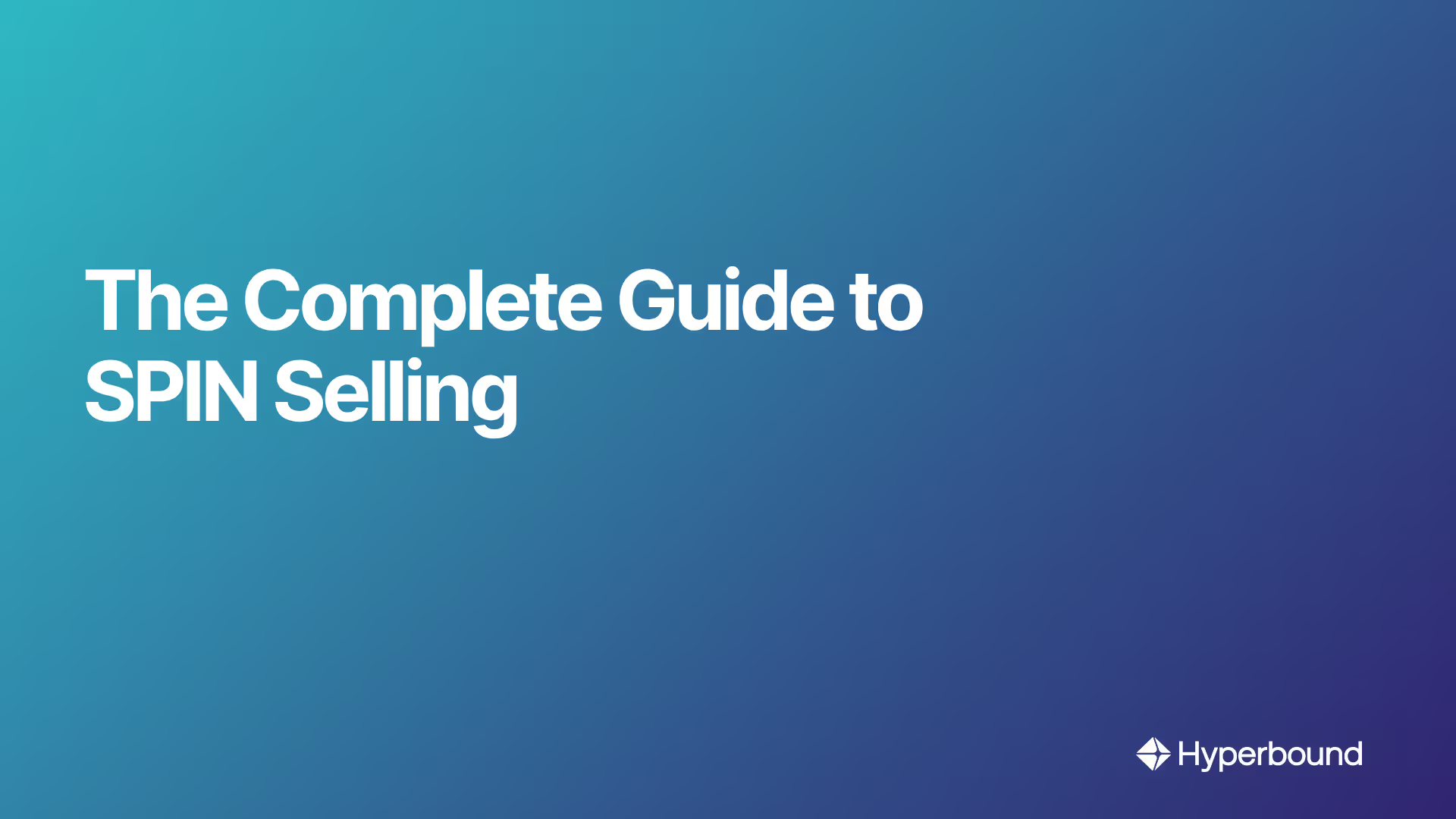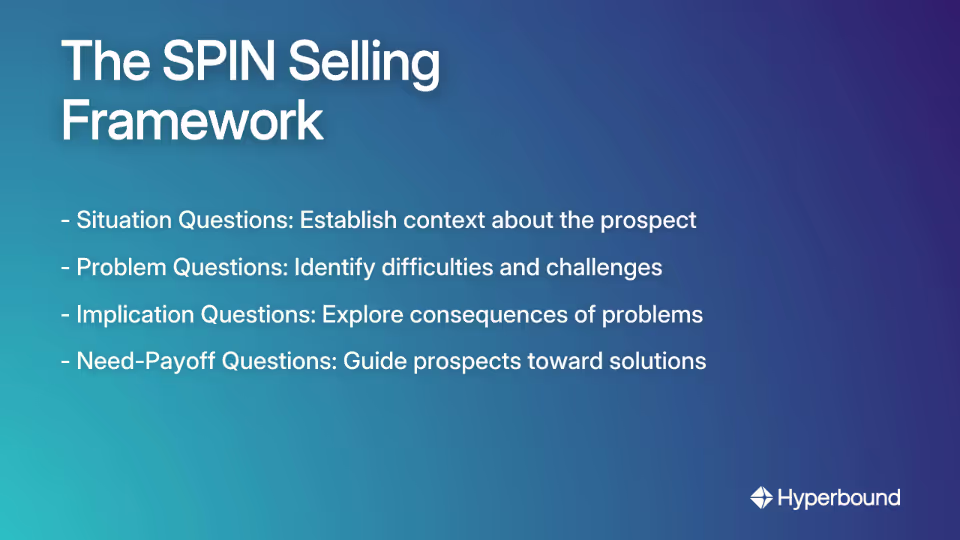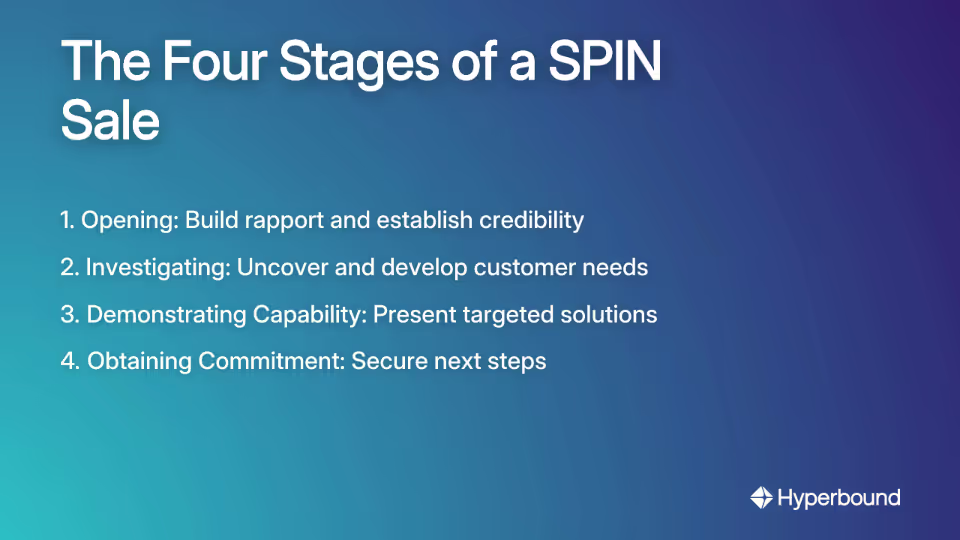
You've sat through another sales call where you talked too much, pitched too early, and walked away without a commitment. Your manager keeps telling you to "ask better questions," but what exactly does that mean? How do you transform from a product-pusher to a trusted advisor that clients actually want to buy from?
The answer might be simpler than you think: stop selling and start asking the right questions.
What is SPIN Selling and Why Is It More Relevant Than Ever?
SPIN Selling is a consultative sales methodology developed by Neil Rackham in the 1980s after analyzing over 35,000 sales calls. Unlike traditional sales techniques that focus on pitching features and closing tactics, SPIN provides a structured framework for uncovering deep customer needs through strategic questioning.
The acronym SPIN stands for the four types of questions at the heart of this methodology:

- Situation
- Problem
- Implication
- Need-Payoff
What makes SPIN Selling particularly relevant today? According to Salesforce's "State of Sales" research, 87% of business buyers now expect sales reps to act as trusted advisors, not just product specialists. The SPIN framework provides exactly the structure needed to meet this expectation.
When implemented correctly, SPIN Selling can enhance sales results by up to 17%, according to research from Huthwaite International, the originators of the methodology. This is because it shifts the focus from your product's features to the customer's world, their problems, and the impact of those problems.
The Four Question Types: The Engine of SPIN Selling
Let's break down each question type and see how they work together to create a powerful sales conversation.
S - Situation Questions: Setting the Stage
Situation questions gather facts and establish context about the prospect's current circumstances. These are your foundation questions, but use them sparingly.
Best Practice: Do your homework before the call. Use these questions to confirm your understanding rather than as a fishing expedition. Too many can bore the prospect and signal that you haven't done your research.
Example Questions:
- "Can you tell me about your role at your company?"
- "What tools do you currently use for your sales process?"
- "How long have you been managing your team?"
- "What are your key priorities this quarter?"
P - Problem Questions: Uncovering Pain
Problem questions identify difficulties, challenges, and dissatisfactions the prospect is experiencing. This is where you begin to uncover "implied needs" - problems your solution might address.
Example Questions:
- "Are you satisfied with your current sales process?"
- "What obstacles do you face in reaching your sales targets?"
- "How time-consuming is it for your team to generate accurate sales reports?"
- "What are the biggest challenges you face with your current tools?"
I - Implication Questions: Raising the Stakes
This is where SPIN Selling truly differentiates itself from other methodologies. Implication questions explore the consequences and ripple effects of the problems you've identified. They help the customer understand the full impact and urgency of their pain points.
According to Huthwaite International, these questions are the most critical in complex, high-value sales. They transform a small problem into a significant business issue by connecting it to costs, time, productivity, or market share.
Example Questions:
- "If your team continues to miss targets, what impact will that have on overall company revenue?"
- "What happens to your team's morale when these reporting challenges occur?"
- "Has the time it takes to do this manual process ever resulted in missed deadlines or opportunities?"
- "How do these efficiency issues affect your competitiveness in the market?"
N - Need-Payoff Questions: Guiding to the Solution
Need-Payoff questions encourage prospects to articulate the value and benefits of solving their problems. Instead of you telling them how great your solution is, they essentially sell themselves on the solution.
Many sales professionals find these questions challenging to deliver without sounding patronizing. The key is to frame them around positive outcomes and business metrics.
Example Questions:
- "How would reducing report generation time from days to hours help your decision-making process?"
- "If you could solve these pipeline visibility issues, what would that mean for your forecasting accuracy?"
- "Would improving team collaboration help you achieve your targets more consistently?"
- "How valuable would it be to eliminate these manual steps in your process?"
The Four Stages of a SPIN Sale
The SPIN questions aren't used randomly - they follow a strategic sequence across four stages of the sales process:

Stage 1: Opening (Preliminaries)
Goal: Build rapport and establish credibility. Your objective is to earn the right to ask questions.
Action: Use a warm, professional opening and transition smoothly into initial Situation questions. Keep this phase brief and focused.
Stage 2: Investigating
Goal: This is the heart of the SPIN sale. You're uncovering and developing the customer's needs from implied to explicit.
Action: Follow the SPIN sequence, starting with a few key Situation questions, then moving to Problem questions. Use Implication questions to expand the customer's perception of their problem, and finally transition to Need-Payoff questions that guide them toward seeing the value of a solution.
Stage 3: Demonstrating Capability
Goal: Present your solution in a way that directly addresses the explicit needs the customer has articulated.
Action: Instead of a generic feature dump, deliver a targeted value proposition. Show how your product provides the exact benefits the customer said they wanted during the Need-Payoff phase.
Stage 4: Obtaining Commitment
Goal: Secure a firm commitment to a specific next step that moves the sale forward.
Action: Based on Rackham's research, aim for one of these outcomes:
- Order: The customer makes a purchase.
- Advance: A clear next step is agreed upon (e.g., "I'll schedule a demo with my CTO for next Tuesday").
- Continuation: A vague, non-committal response ("Thanks, we'll be in touch"). This is a hidden failure.
- No-Sale: The customer rejects the proposal.
Best Practices for Mastering SPIN Selling
Do Your Homework
Never ask a Situation question if the answer is on the prospect's website or LinkedIn profile. Thorough research builds credibility and allows you to focus your time on more valuable Problem and Implication questions.
Listen More, Talk Less
As one sales professional on Reddit noted, "A good tactic is listening more than talking during the sales process." SPIN Selling is fundamentally about active listening, not monologuing. The most successful practitioners spend 70-80% of the conversation listening.
Keep Your CRM Notes Immaculate
Another sales professional bluntly warns: "Keep your CRM notes up to date. This is underrated by so many people. You are affecting your future success by not keeping decent notes." Detailed records of the S, P, I, and N details from each call are essential for effective follow-up and long-term success.
Personalize Your Follow-Up
While not part of the original SPIN methodology, adding personalized touches builds the kind of genuine relationships that SPIN aims to create. As one salesperson shared, "Sending hand-written thank-you notes after a meeting can really make a difference."
Why Effective SPIN Sales Training is Crucial
Many salespeople express frustration with inadequate sales training that consists of "a string of recorded product demonstrations made by marketing," as one professional complained. This approach fails because SPIN is a skill, not a script.
Mastering SPIN requires behavioral change. It's about learning how to think and listen differently, which can only be achieved through practice. According to Huthwaite International, effective SPIN training should be:
- Interactive and Practical: Focused on role-playing and applying techniques to real sales scenarios
- Coaching-Oriented: Involving continuous feedback and development
- Focused on Consistency: Aiming to standardize a consultative approach across the entire sales team
This is where AI-powered sales coaching and roleplay platforms come in. They provide the safe, repeatable practice environment needed to turn theoretical knowledge into real-world skill, delivering the instant feedback necessary for rapid improvement.

Become the Advisor Your Customers Need
SPIN Selling transforms the sales conversation from a pitch into a collaborative diagnosis. By asking thoughtful Situation, Problem, and Implication questions, you empower customers to see the value of your solution for themselves through Need-Payoff questions.
The beauty of SPIN is that it aligns perfectly with how modern buyers want to buy. They don't want to be sold to; they want to be understood and guided toward the right solution for their specific needs.
Start small. For your next sales call, plan three powerful Problem and Implication questions. Focus entirely on listening to the answers. This is the first step toward building the trust-based relationships that define modern sales success and, ultimately, toward becoming the trusted advisor that today's buyers demand.
Remember, in the words of Neil Rackham himself, "Successful selling isn't about presenting solutions; it's about asking the right questions to understand the problem." Master the SPIN methodology, and you'll never have to "sell" again – your customers will sell themselves.
Frequently Asked Questions
What is SPIN selling?
SPIN selling is a consultative sales methodology that uses a structured sequence of four question types—Situation, Problem, Implication, and Need-Payoff—to uncover customer needs and guide them toward a solution. Developed by Neil Rackham, this approach shifts the focus from pitching products to understanding a customer's world. By asking strategic questions, sales reps help prospects identify the full impact of their problems and articulate the value of solving them, making it a highly effective advisory selling technique.
Why is the SPIN methodology so effective in modern sales?
The SPIN methodology is highly effective today because it aligns perfectly with modern buyer expectations. Customers want trusted advisors, not aggressive salespeople, and SPIN provides the framework to build that trust. Research shows that the vast majority of business buyers expect sales reps to act as strategic partners. SPIN selling moves the conversation from a product-focused pitch to a customer-centric dialogue. This process helps build rapport and credibility, leading to stronger relationships and increased sales success.
What is the most important question type in SPIN selling?
Implication questions are widely considered the most important and powerful type in the SPIN selling framework, especially in large or complex sales. While all four question types are essential, Implication questions are what elevate the conversation. They help the prospect connect their identified problems (from Problem questions) to their broader business consequences, such as lost revenue, decreased productivity, or competitive disadvantages. This process builds the urgency and financial justification needed to make a change.
How do I transition between the different SPIN question types?
Transitioning between SPIN questions should feel like a natural conversation, not an interrogation. The key is active listening. After gathering context with Situation questions, listen for a hint of difficulty. Use that to ask a Problem question (e.g., "You mentioned you use X tool. How satisfied are you with its reporting capabilities?"). Once a problem is confirmed, explore its effects with an Implication question ("How does that delay in reporting affect your team's ability to make decisions?"). Finally, pivot to the solution with a Need-Payoff question ("If you could get those reports instantly, how would that help?").
What are common mistakes to avoid when using SPIN selling?
The most common mistakes are asking too many Situation questions, pitching the solution too early, and failing to develop the implications of a problem. Asking basic Situation questions that could be answered with research makes you look unprepared. Jumping to your product's features after uncovering a minor problem bypasses the crucial Implication and Need-Payoff stages, which are essential for building value. A successful SPIN conversation patiently develops a small pain point into a significant business issue that your solution is perfectly positioned to solve.
Is SPIN selling only for large, complex sales?
While SPIN selling was originally studied and is most famous for its effectiveness in large, complex B2B sales, its principles can be adapted for smaller, transactional sales as well. For simpler sales, the process may be shorter. You might only need one or two strong Problem and Implication questions to establish a need. The core principle of understanding the customer's problem before presenting a solution is universally effective. The key is to scale the depth of your investigation to the complexity of the sale.
Book a demo with Hyperbound
.png)













